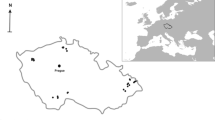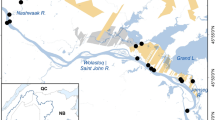Abstract
Local abundance of animals with aquatic and terrestrial life stages may be useful to determine criteria for protective buffers around wetlands. Maiden flights and daily commutes of adult Odonata (damselflies, dragonflies) occur between wetland breeding area and adjacent upland habitat used for foraging, maturation, and nocturnal roosting. We measured abundance of dragonflies adjacent to a wetland in Mississippi, USA to determine if abundance varied with distance from water. Sexually mature males and combined females/prereproductive adult males (females-immatures) were recorded 10– 160 m from the littoral edge of a 185 ha shallow reservoir. The number of dragonflies was dominated by Celithemis eponina throughout the study period. Mean abundance did not change with distance from water out to 160 m, both for all species combined and for each of three dominant species. In the assemblage, mature males outnumbered females-immatures in the 10–40 m distance, whereas the reverse occurred in the 130–160 m distance. At the species-level, there was a mixed response in the mature male: female-immature ratio, with little resemblance to the assemblage pattern. Results of this study suggest that wide buffer zones around wetlands may be essential to protect Odonata assemblages, especially females and sexually immature adults. Furthermore, odonate flight behavior may serve as a useful biocriterion to determine the width of ecologically significant wetland buffers.
Similar content being viewed by others
Literature Cited
Barone, J. A. 2005. Historical presence and distribution of prairies in the Black Belt of Mississippi and Alabama. Castanea 70: 170–183.
Bick, G. H. and J. C. Bick. 1965. Demography and behavior of the damselfly, Argia apicalis (Say). Ecology 46: 461–472.
Bried, J. T. 2005. Community and conservation ecology of dragonfly and damselfly adults in Mississippi wetlands. M.S. Thesis. Mississippi State University, Starkville, MS, USA.
Chovanec, A. 1994. Man-made wetlands in urban recreational areas—a habitat for endangered species? Landscape and Urban Planning 29: 43–54.
Conrad, K. F., K. H. Williams, I. F. Harvey, C. J. Thomas, and T. N. Sherratt. 1999. Dispersal characteristics of seven odonate species in an agricultural landscape. Ecography 22: 524–531.
Corbet, P. S. 1980. Biology of Odonata. Annual Review of Entomology 25: 189–217.
Corbet, P. S. 1999. Dragonflies: Behavior and Ecology of Odonata. Cornell University Press, Ithaca, NY, USA.
Corbet, P. S. and R. Hoess. 1998. Sex ratio of Odonata at emergence. International Journal of Odonatology 1: 99–118.
Faccio, S. D. 2003. Postbreeding emigration and habitat use by Jefferson and Spotted salamanders in Vermont. Journal of Herpetology 37: 479–489.
Fried, C. S. and M. L. May. 1983. Energy expenditure and food intake of territorial male Pachydiplax longipennis (Odonata: Libellulidae). Ecological Entomology 8: 283–292.
Gibbons, J. W. 2003. Terrestrial habitat: a vital component for herpetofauna of isolated wetlands. Wetlands 23: 630–635.
Hamilton, L. D. and R. D. Montgomerie. 1989. Population demography and sex ratio in a Neotropical damselfly (Odonata: Coenagrionidae) in Costa Rica. Journal of Tropical Ecology 5: 159–171.
Homan, R. N., B. S. Windmiller, and J. M. Reed. 2004. Critical thresholds associated with habitat loss for two vernal poolbreeding amphibians. Ecological Applications 14: 1547–1553.
Hornung, J. P. and C. L. Rice. 2003. Odonata and wetland quality in southern Alberta, Canada: A preliminary study. Odonatologica 32: 119–129.
Johnson, C. 1962. A study of territoriality and breeding behaviour in Pachydiplax longipennis Burmeister (Odonata: Libellulidae). Southwestern Naturalist 7: 191–197.
Jonsen, I. D. and P. D. Taylor. 2000. Fine-scale movement behaviors of Calopterygid damselflies are influenced by landscape structure: an experimental manipulation. Oikos 88: 1–9.
Lutz, P. E. and A. R. Pittman. 1970. Some ecological factors influencing a community of adult Odonata. Ecology 51: 279–284.
McVey, M. E. 1988. The opportunity for sexual selection in a territorial dragonfly, Erythemis simplicicolis. p. 44–58, In T. H. Clutton-Brock (ed.) Reproductive Success. University of Chicago Press, Chicago, IL, USA.
Michiels, N. K. and A. A. Dhondt. 1989. Differences in male and female activity patterns in the dragonfly Sympetrum danae (Sulzer) and their relation to mate-finding (Anisoptera: Libellulidae). Odonatologica 18: 349–364.
Michiels, N. K. and A. A. Dhondt. 1991. Sources of variation in male mating success and female oviposition rate in a non-territorial dragonfly. Behavioral Ecology and Sociobiology 29: 17–25.
Milam, J. 2001. Ode to Odonates: dragonflies and damselflies in distress. National Wetlands Newletter 23(3): 3–4, 24–25.
Miller, P. L. 1982. Observations on the reproductive behaviour of Celithemis eponina Drury (Libellulidae, Odonata). Entomologist’s Monthly Magazine 117: 209–212.
Miller, P. L. 1989. Communal roosting in Potamarcha congener (Rambur) and its possible functions (Anisoptera: Libellulidae). Odonatologica 18: 179–194.
Neubauer, K. and G. Rehfeldt. 1995. Roosting site selection in the damselfly species Calopteryx haemorrhoidalis (Odonata: Calopterygidae). Entomologia Generalis 19: 291–302.
Parr, M. J. and M. Palmer. 1971. The sex ratios, mating frequencies and mating expectancies of three coenagrionids in northern England. Entomology Scandinavia 2: 191–204.
Parr, M. J. and M. Parr. 1974. Studies on the behavior and ecology of Nesciothemis nigeriensis Gambles. Odonatologica 3: 21–47.
Petersen, I., Z. Masters, A. G. Hildrew, and S. J. Ormerod. 2004. Dispersal of adult aquatic insects in catchments of differing land use. Journal of Applied Ecology 41: 934–950.
Purse, B. V., G. W. Hopkins, K. J. Day, and D. J. Thompson. 2003. Dispersal characteristics and management of a rare damselfly. Journal of Applied Ecology 40: 716–728.
Roe, J. H., B. A. Kingsbury, and N. R. Herbert. 2003. Wetland and upland use patterns in semi-aquatic snakes: implications for wetland conservation. Wetlands 23: 1003–1014.
Samways, M. J. and N. S. Steytler. 1996. Dragonfly (Odonata) distribution patterns in urban and forest landscapes, and recommendations for riparian management. Biological Conservation 78: 279–288.
Semlitsch, R. D. and J. R. Bodie. 2003. Biological criteria for buffer zones around wetlands and riparian habitats for amphibians and reptiles. Conservation Biology 17: 1219–1228.
Switzer, P. V. 1997. Factors affecting site fidelity in a territorial animal, Perithemis tenera. Animal Behavior 53: 865–877.
Ueda, T. and M. Iwasaki. 1982. Changes in the survivorship, distribution and movement pattern during the adult life of a damselfly, Lestes temporalis (Zygoptera: Odonata). Advances in Odonatology 1: 281–291.
Von Ende, C. V. 2001. Repeated-measures analysis: Growth and other time-dependent measures. p. 134–157, In S. M. Scheiner and J. Gurevitch (eds.) Design and Analysis of Ecological Experiments. Oxford University Press, New York, NY, USA.
Watanabe, M. and T. Higashi. 1989. Sexual difference of lifetime movement in adults of the Japanese Skimmer, Orthetrum japonicum (Odonata: Libellulidae), in a forest-paddy field complex. Ecological Research 4: 85–97.
Westfall, M. J., Jr. and K. J. Tennessen. 1996. Odonata. p. 164–211, In R. W. Merritt and K. W. Cummins (eds.) An Introduction to the Aquatic Insects of North America. Kendall/Hunt Publishing Company, Dubuque, IA, USA.
Wissinger, S. A. 1999. Ecology of wetland invertebrates: Synthesis and applications for conservation and management. p. 1043–1086, In D. P. Batzer, R. B. Rader, and S. A. Wissinger (eds.) Invertebrates in Freshwater Wetlands of North America: Ecology and Management. John Wiley & Sons, Inc., New York, NY, USA.
Author information
Authors and Affiliations
Corresponding author
Rights and permissions
About this article
Cite this article
Bried, J.T., Ervin, G.N. Abundance patterns of dragonflies along a wetland buffer. Wetlands 26, 878–883 (2006). https://doi.org/10.1672/0277-5212(2006)26[878:APODAA]2.0.CO;2
Received:
Revised:
Accepted:
Issue Date:
DOI: https://doi.org/10.1672/0277-5212(2006)26[878:APODAA]2.0.CO;2




